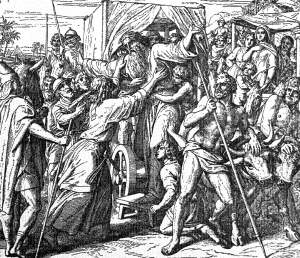 Joseph prepared gifts for his brothers to take back to Jacob. He also sent wagons full of food. He told them to return to Chanaan to bring back Jacob and all their families and goods to Egypt.
Joseph prepared gifts for his brothers to take back to Jacob. He also sent wagons full of food. He told them to return to Chanaan to bring back Jacob and all their families and goods to Egypt. Joseph prepared gifts for his brothers to take back to Jacob. He also sent wagons full of food. He told them to return to Chanaan to bring back Jacob and all their families and goods to Egypt.
Joseph prepared gifts for his brothers to take back to Jacob. He also sent wagons full of food. He told them to return to Chanaan to bring back Jacob and all their families and goods to Egypt.
When his sons told Jacob that Joseph was alive, he could not believe the news. But when he saw the gifts and wagons, he exclaimed, "Joseph really lives! I will go and see him before I die."
Soon they set out for Egypt. One night, as Jacob slept, God said to him, "Fear not. Go to Egypt. There I will make of you a great nation. And I will surely bring you back to Chanaan."
In order to let Joseph know of their arrival, Juda went ahead of the rest. Joseph, riding in his chariot, went to meet Jacob in Gessen. Upon seeing his father, he embraced him and wept with joy. In his happiness Jacob cried out, "Now I shall die with joy, for I have seen your face, and know that you are alive!"
With the king's consent, Joseph gave his father and his brothers rich land in Gessen, where they were to live and pasture their flocks. He gave the king's cattle in their charge. He presented Jacob to the king, whom Jacob blessed.
The Israelites lived in Gessen seventeen years. Jacob died there when he was one hundred forty-seven years old. Before his death he charged Joseph to bury him with Abraham and Isaac back in Chanaan. Then he called his twelve sons, and gave each one a blessing.
To Juda he gave the greatest blessing, saying: "You shall rule over your enemies. The sons of your father shall bow down before you. The sceptre shall not be taken away from Juda till He come that is to be sent, and He shall be the Expectation of Nations."
This prophecy, which clearly foretold the time when the Messias would come, was accomplished when Herod, the first foreigner, ruled over Judea. In Herod the sceptre passed from Juda.
And then Jesus Christ was born, as it had been foretold.
- from My Bible History in Pictures, by Bishop Louis LaRavoire Morrow, D.D., 1934; it has the Imprimatur of Archbishop Michael J O'Doherty of Manila, Philippines